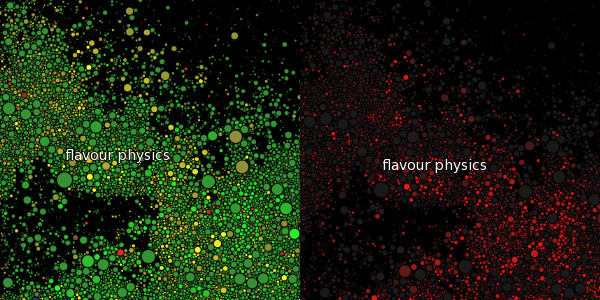Our original colouring scheme for the generated Paperscape map assigns the arXiv categories (mostly) unique colours to easily distinguish them. This colour coding shows clearly how authors cite mostly within their own fields, as well as revealing interesting interfaces between the different categories. For example, check out the fields of dark matter (astrophysics meets high energy phenomenology) and dark energy (high energy theory meets general relativity/quantum cosmology meets astrophysics). However, the cost of using colour to code categories is that other features, such as a paper’s age, must be shown in a different way. Specifically, we use brightness to highlight newer papers in this scheme, but, due to all the different colours present, new regions of papers don’t really shine through.
Enter our new heatmap, which purely shows the age of papers using a colour gradient from dark gray (old) to bright red (new). The heatmap can be activated using the new drop down menu located at the top left of the map. In this new colouring scheme regions of recent activity stand out much more clearly, and new papers that are growing quickly can be easily identified. If you haven’t yet, go visit the Paperscape map to try it.

Now for some details. We found that a linear mapping of the arXiv’s paper ages (spanning 23 years) to the chosen colour gradient wasn’t sufficient to highlight recent activity. After trying various mappings, we’ve opted for a Voigt profile with a sigma of 4 years and a gamma of 1/27 inverse years. These values simply represent what we think best distinguishes what’s currently hot with what’s not. We’ll probably continue to tune the heatmap in the future, and your suggestions are very welcome!
By giving the map two different colour schemes, the question of whether there are other interesting colour schemes naturally arises. It could for example be useful to highlight trending papers i.e. papers that are growing quickly in their number of citations, irrespective of their age. If you have any good ideas please share them!